SEEKING JUSTICE IN NEW MEXICO MOUNTAINS
Enchanted Mountain Guides – Albuquerque, NM
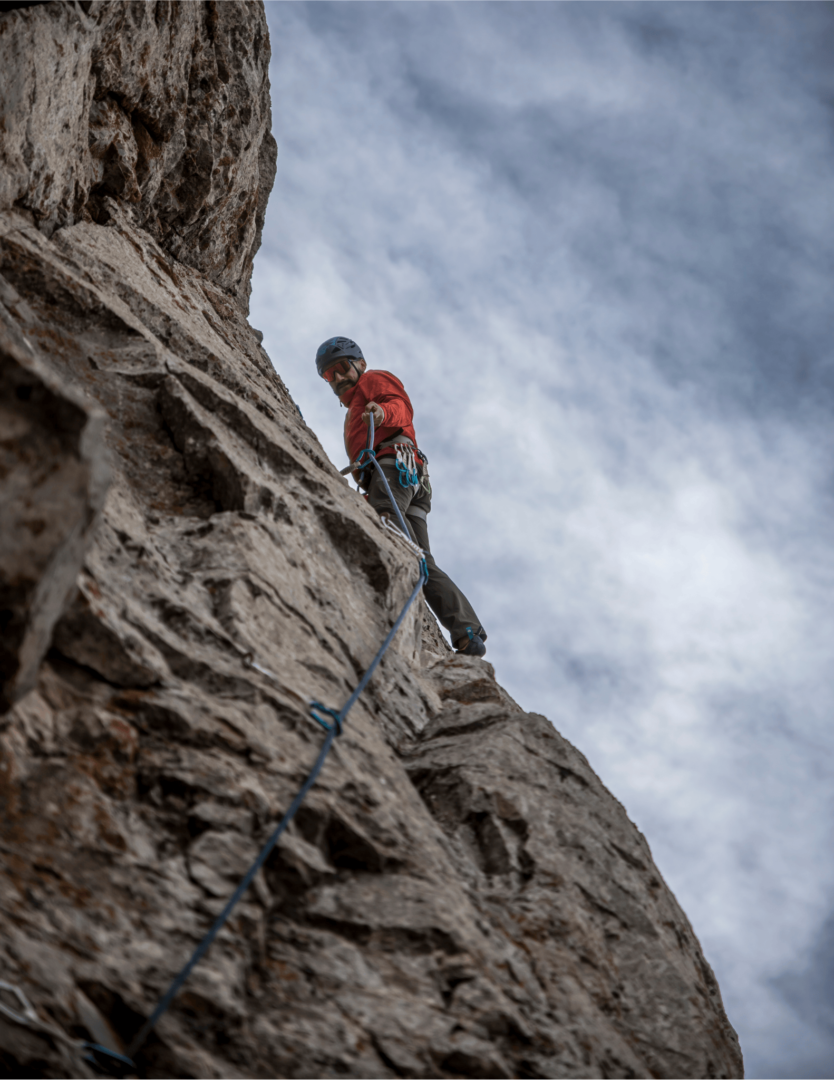
Josue De Luna Navarro attaches a thick, climbing rope to a quick draw device, which is essentially two carabiners connected via a heavy sling. One carabiner uses a straight gate opening and connects to an anchoring clip, while the other carabiner has a bent clipping gate and allows the climbing rope to slide through. He gazes up at a rounded hump near the top of Sandia’s Crest, then he starts up, using his sticky, climbing shoes for purchase and finding hand holds as he progresses. The rope, his partner, Joshua Jarrín, explains, is there for safety.
“So for me as a guide, we come with a rope. And all we need are these quickdraws. We are going to connect the rope to these anchors that have been previously drilled into the rock,” he says. “So the purpose of sport climbing is just to come and climb the hardest possible moves. And we have previously worked the safety of that, although somebody else already drilled the anchors. The other alternative for rock climbing is to do traditional climbing, where the challenge is not only the climbing, the movement, but also figuring out the safety.”
Jarrín and De Luna Navarro run Enchanted Mountain Guides out of Albuquerque, but their business provides a range of outdoor adventure services, like guided, back-country skiing trips, introductory, intermediate and advanced climbing lessons. They can even arrange big-mountain treks to not only places like Denali in Alaska, but also in South America, Europe and the Himalayas.
“For rock climbing, we can start here in Albuquerque, but we also go to Santa Fe. We can also take people to the Taos area. We’ve had this nonprofit group hire us to go down to Las Cruces to the Organ Mountains. And Socorro for the Box,” De Luna Navarro says after he reached the apex of his climb and then mini-rappelled back down. “In Santa Fe, well, there’s this one little crag off the Hyde Park Road as part of the Santa Fe Open Space. In the past, we’ve also taken people to Diablo Canyon.”
Both De Luna Navarro and Jarrín are members of the American Mountain Guides Association and Jarrín has experience climbing all over the world, including cresting Mount Everest.
“And so during the summer, Joshua has clients that are hiring him to go to the Alps, to go more to, like, the European mountains,” De Luna Navarro explains. “We also have a network of guides for clients that want to go down to Ecuador or to Mexico to climb the big, big volcanoes. And then in the ski discipline, we’ve hosted introductory backcountry classes like backcountry skiing and rescue classes in the Santa Fe backcountry.”
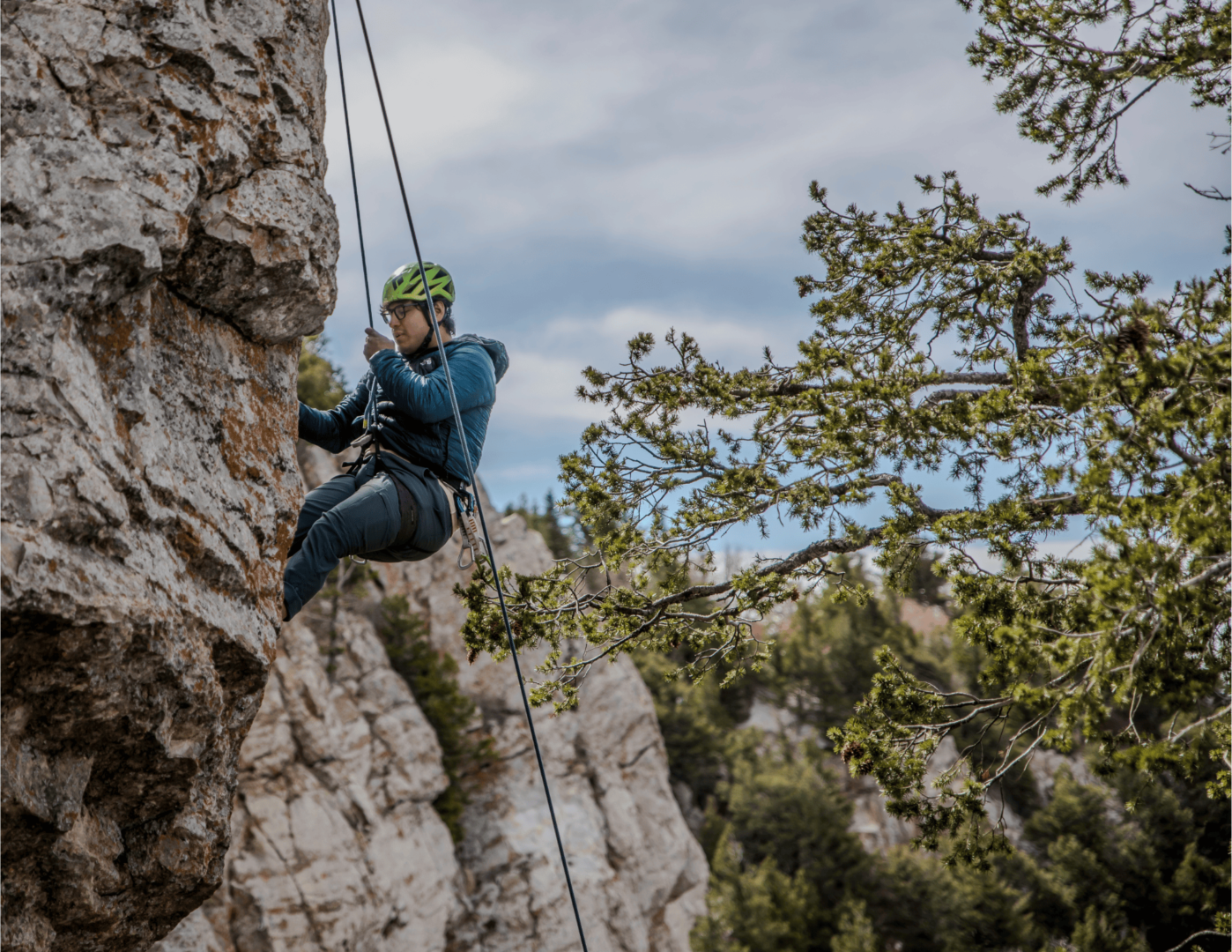
CLIMBING ROOTS
Born in Mexico, De Luna Navarro and his family immigrated to Santa Fe when he was nine. And that presented challenges for the youngster that led him to seek a means of finding his own place. And that space turned out to be the nearby mountains.
“Because of the reality of being an immigrant, and also living in neighborhoods where us, as youth, felt like we were being policed in our neighborhoods, naturally the mountains and the idea of going on adventures, specifically with my brother, to have an escape where we felt free, where we felt that freedom of movement, naturally, the mountains became that refuge for us,” he says.
Following high school, De Luna Navarro attended the University of New Mexico, where he earned an undergrad degree in chemical engineering and landed a job in Washington D.C. at a progressive think tank.
“With my background of being an engineer and in science, I was writing op-eds, and publications around what we needed to do; policy-level solutions to the climate crisis,” he says. “And that’s been the closest I’ve worked with my degree in science. But for most of my career, it’s always been community driven, kind of like grassroots policy change.”
But the mountains not only maintained a lure, they continued to reach out to him, almost calling him back home.
For Jarrín, who was born and raised in Quito, Ecuador, climbing was in his blood from the outset as his family enjoyed the outdoors and his parents encouraged their children to get out into nature as much as possible.
“Quito is next to the mountains, so it’s a natural activity to do when you grew up there. I started first with hiking in kind of a similar version to what Scouts of America is in the U.S.; something like that,” he says. “And then I transitioned into rock climbing. Later, I travelled around the world and I followed different mountain guide programs. And 11 years ago, I moved to the U.S. I was already a mountain guide and I joined the American Mountain Guide Association. That’s how I practice it professionally in the U.S.”

A PARTNERSHIP IS BORN
“When I really got into rock climbing, and I saw the opportunity to grow as a guide, and be guiding bigger climbs, specifically, like in New Mexico, like in the Sandia Mountains or in other parts of the country. But one of the things that you face is that you need a mentor, someone that has gone through the whole process of climbing, big objectives,” he says. “And growing up as a brown, immigrant kid, I always felt kind of out of place because the outdoor community is predominantly white. And I just didn’t see myself reflected in anyone, being from the same background or same culture.”
And while searching social media, he realized it was time to go back to New Mexico and follow his heart.
“One day, I was looking through (social media) and I just kind of searched Sandia rock climbing,” De Luna Navarro says. “And I realized that one of those posts was written in Spanish. Then I realized that that was Joshua. And that he was from Ecuador and that he was living in Albuquerque.”
The two men had crossed paths through the Albuquerque climbing network, but had not really met each other. But after seeing their similarities, De Luna Navarro made contact with Jarrín.
“He was an instructor at the school of mountain guides, the American Mountain Guide Association, and I had already kind of seen him around the climbing gym, and through different events,” he says of Jarrín. “So that was a moment where I realized I really need to reach out to him because he will understand me since we share the same experience of being immigrant, Spanish-speaking, brown people in the mountains. And so that was kind of a good deal for me so I asked him to be my mentor. We started our climbing relationship that way, kind of him showing me how to do things in the context of guiding, how to kind of work myself through guiding.”
So Jarrín played the role of mentor, guide and, eventually, business partner when the two started Enchanted Mountain Guides in 2022.
“It’s been a dream to start this company and champion mountain guides and to have a company that really values the profession of mountain guiding in New Mexico that is owned by people of color,” De Luna Navarro says. “And also we have full autonomy of how to create a business model, where we can re-invest our revenue and our profit into the training of other guides of color here in New Mexico. And so we create this pipeline of work professions, in leadership among the youth in our communities and people in our communities who have always had the dream of working in the mountains, but may not have found those opportunities here in New Mexico. So we started the company.”
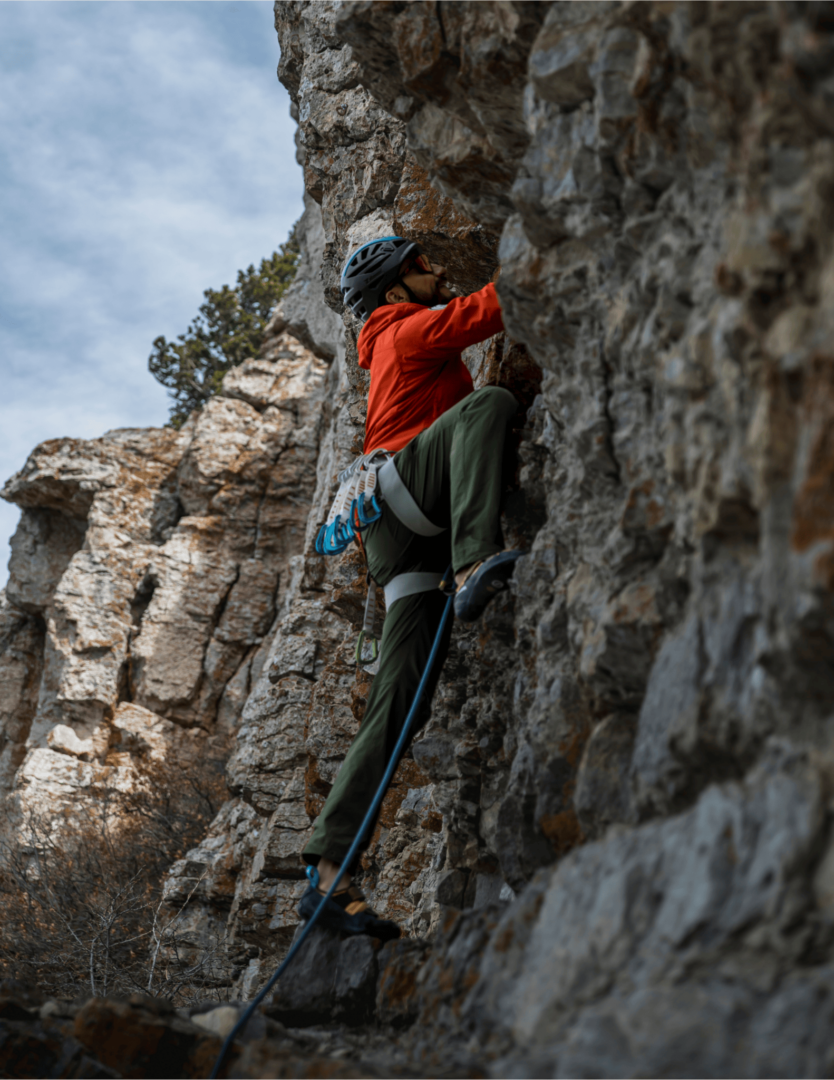
CAN’T BEAT NEW MEXICO
“What I love about New Mexico is you can guide here in the winter and summer, all four seasons,” Jarrín says. “That’s fun. I have climbed all over the world but the geology of New Mexico from the rock climbers’ perspective is world class and that makes it interesting here compared to other areas. If you look at the rocks down there, more brownish-pink fissures, that’s granite. We’re standing right now in limestone, the limestone so we can use those to offer two different, very different styles of movement for the climbing. The limestone is full of features, horizontal features where I can grab like this and then grab the tension.”
The granite, however, presents different challenges.
“The breaks are more like vertical breaks,” he says. “So we go more with our hands in the cracks and jam our hands and feet. It’s a different technique. And we have all of that 20 minutes from home. Then if we talk an hour or more around Albuquerque, you have sandstone in Diablo Canyon in Santa Fe combined with a basalt column that is great quality. You have granite here, a limestone here and in the whole state of New Mexico. You go to Questa and you have a dome that’s Yosemite quality, like the best of granite that you can find. And down in Las Cruces is the same type of granite and the mountains look like the Alps, it is very, very similar. For climbing people, it’s kind of off the radar but the climbing is very good.”
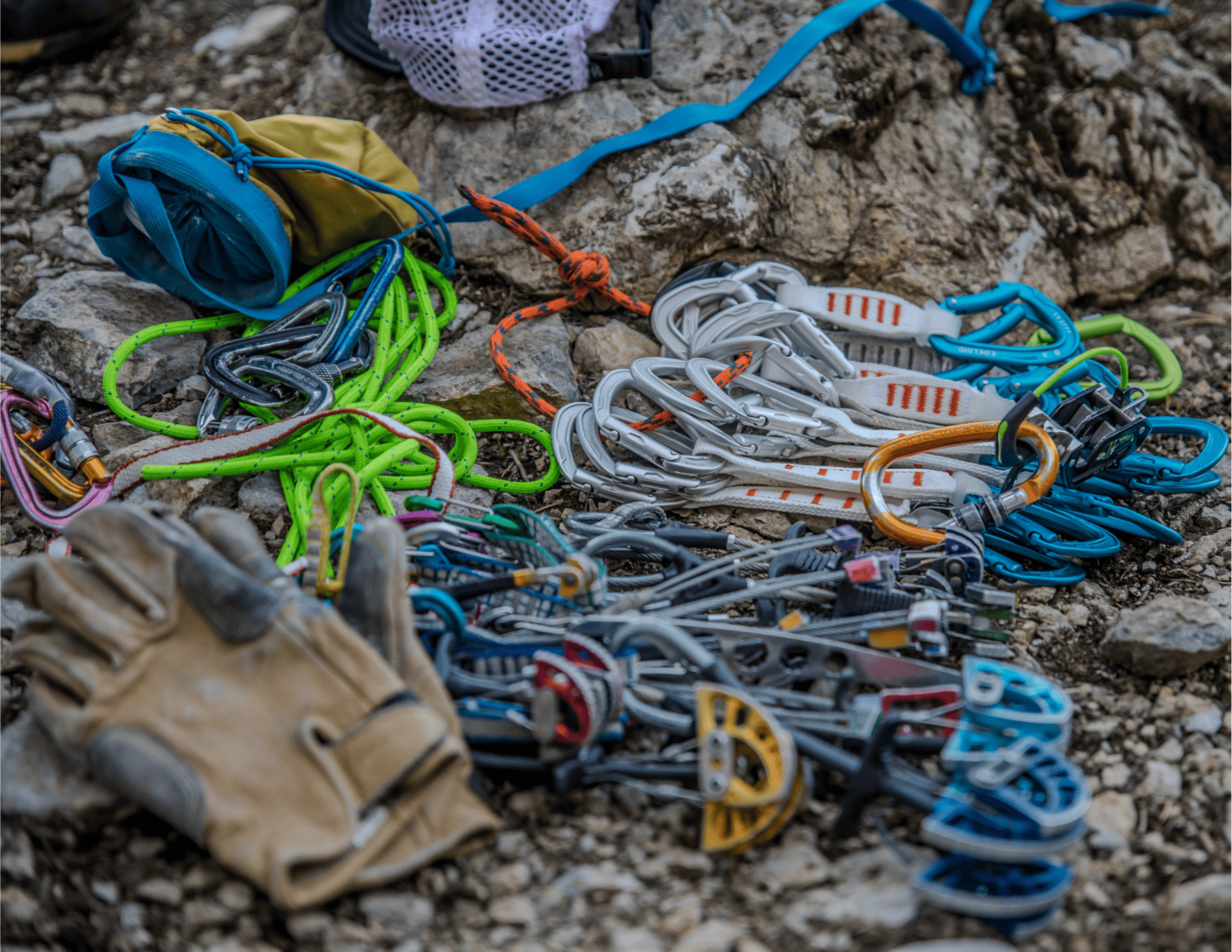
SOCIAL JUSTICE OUTDOORSMEN
As De Luna Navarro became more comfortable in his role as an outdoorsman, he saw it as a means for others like him to find that similar escape.
“Most of my years as a high school student and as a college student, and even after college, I was very involved in the community through social justice movements,” he says. “And so it’s been, what, eight years now where I saw how the outdoors could benefit us of color and using the community to go outdoors and to connect with the mountain through different activities right through, like rock climbing, backpacking, hiking, snowshoeing, and even skiing. And that was when I first got a glimpse of this opportunity of working as a guide, or even the career of a guide, or the role of an outdoor educator, came into my life. It was really trying to see or seek opportunities to become a better leader for my community, and have more skills and tools to take my community out to the mountains.”
The more De Luna Navarro explored the idea of sharing his love for the outdoors with others, particularly, people of color, the more the idea of doing it as a livelihood continued to grow.
“Then I got really interested in mountain guiding as a career in the idea of sharing awesome experiences, of being with people from all over the world from all different backgrounds, enjoying the same thing, which is being close to nature, connecting with the mountain and going and building friendship, really,” he says. “And that’s what really got me hooked into the profession of being a mountain guide.”
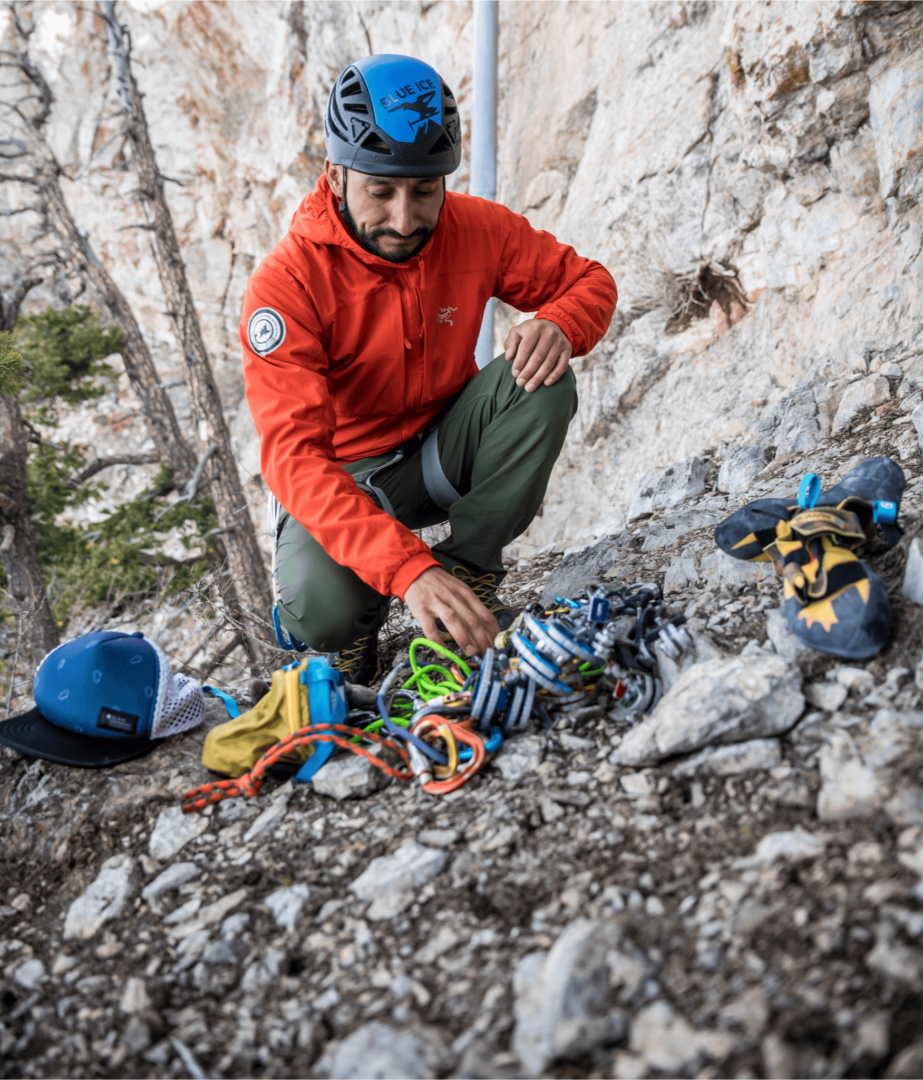
LOOKING UP
As a guide, climbing is not so much an interaction between the climber and surface as it is building a trusting relationship with the student. For the newcomer, the array of equipment can be a dizzying experience even before hitting the mountains. But that’s where the expertise of Jarrín and De Luna Navarro comes into play.
“What we do with our clients, we teach people how to use all these things,” Jarrín says, indicating the ropes and the carabiners and the harnesses and the anchors. “Normally, people transition in the sport starting at the climbing gym, and then they want to learn a little bit of sport climbing that is less-gear intense. And then we can move into traditional climbing. So then we are dealing with many different pieces of equipment. And we are trying to serve all that public, teaching them from how to tie into the rope, the very first basic knot all the way to doing faces with no preset equipment when you have to bring everything and figure out the whole thing.”
Both men smile broadly as Jarrín continues to explain.
“And then we use this other equipment. That is, normally we are going to jam these things, the quickdraws, into the rock,” he says. “And also we need to figure out not only how to get up there, but also how to connect the rope to the terrain. So this (the Sandias) is a sport climbing area. Pretty much all the links were already on the wall. And usually in these sport climbs, there’s two poles at the top, where if you will build an anchor, and then the rope gets lowered, so that if I was the client, in this case, I can climb up on top and the rope is already at the top. In case I fall, I need a break. I can just hang, suspending there and I don’t fall. It’s a more safe way for clients. So the mechanics of these things are like this; I’m connected, tied on the end of the rope. He has a belay device that will control the transit of the rope. And I will be connecting the rope to the terrain from time to time with these quickdraws. So if I take a fall, these devices will start the rope break and I will fall until the last point of connection. That’s how it works. It works like a counterbalance thing.”
And it works because two men are dedicated to their craft, to their community and to seeing it grow in New Mexico.
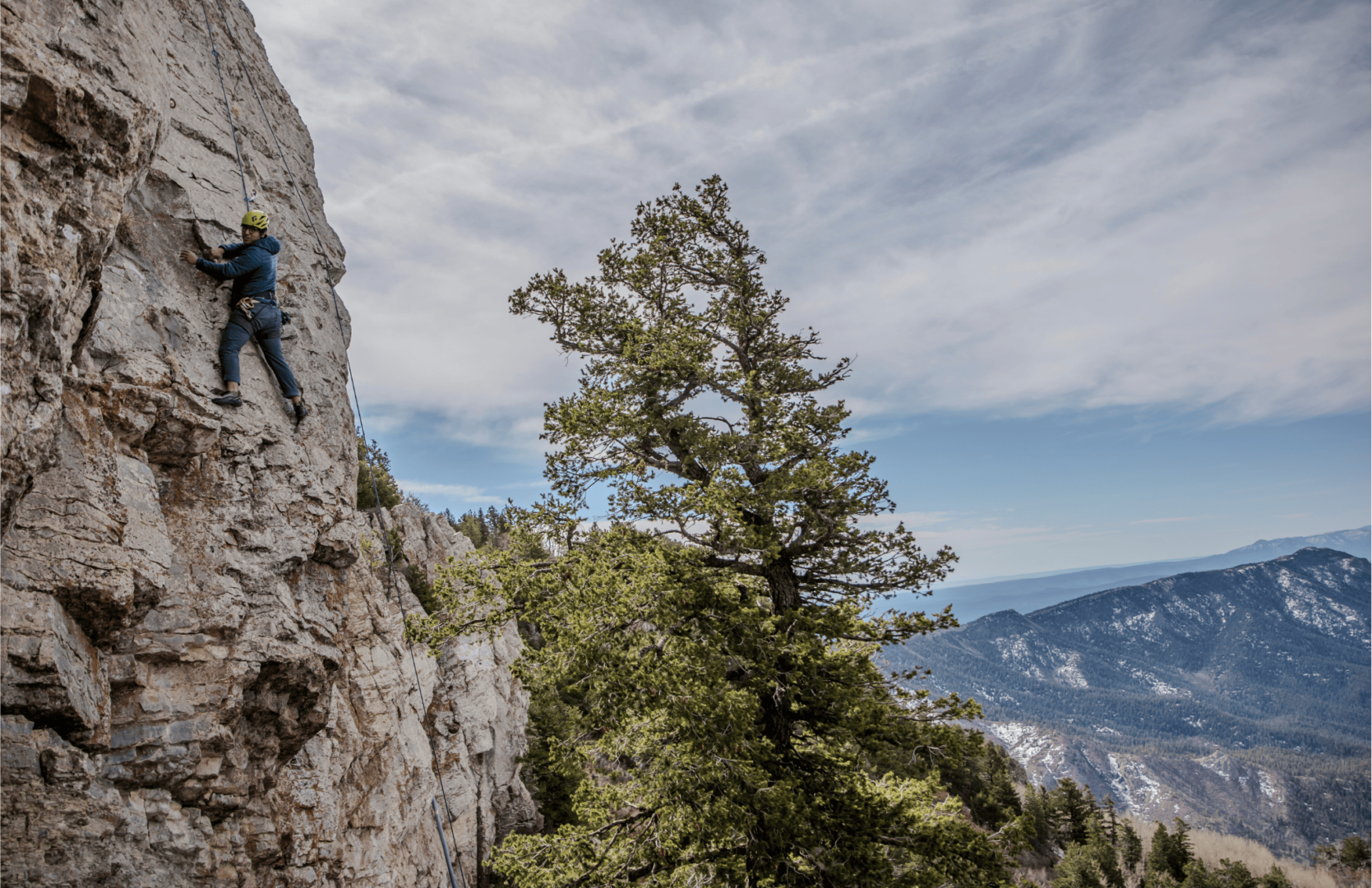
Photos by Mike Sandoval Editorial by Glen Rosales
Enchanted Mountain Guides – Albuquerque, NM